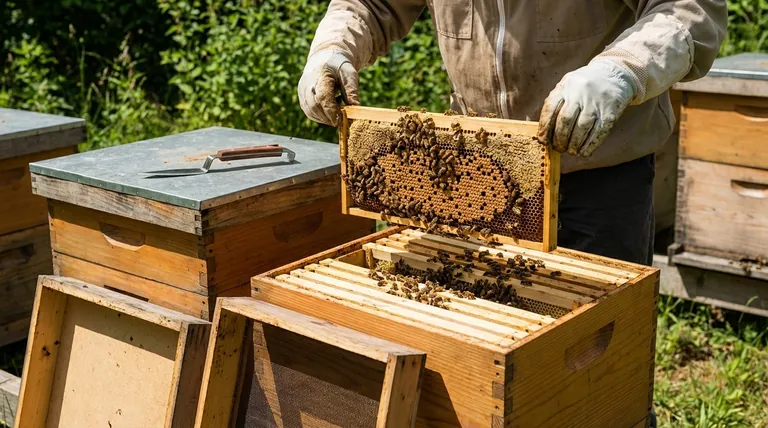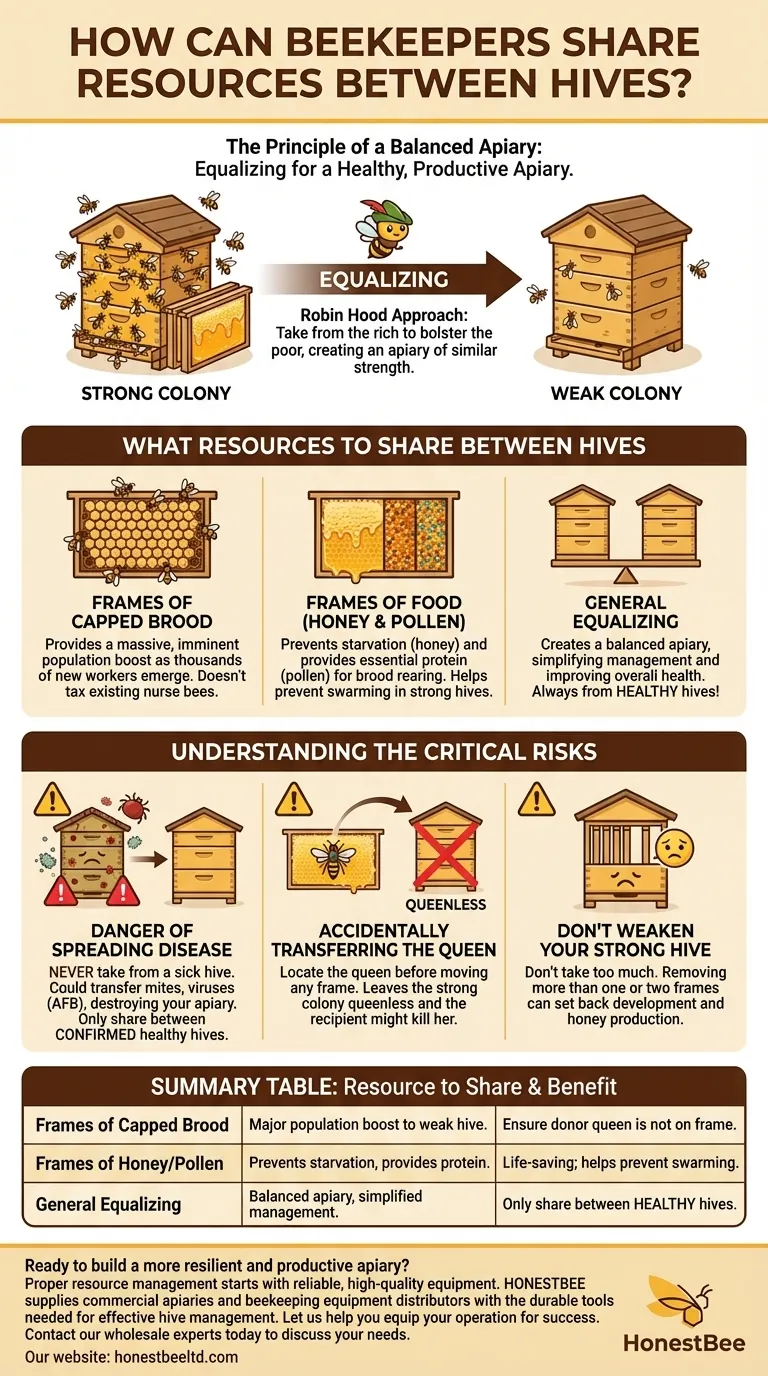The short answer is yes. Beekeepers can and should share resources between hives by moving frames of bees, brood, and food from a strong colony to a weaker one. This management technique, known as equalizing, is a fundamental tool for maintaining a healthy and productive apiary.
Equalizing hives is the practice of taking resources from your strongest colonies to bolster your weakest ones. The goal is not just to save a struggling hive, but to create an entire apiary of colonies with similar strength, which simplifies management and improves overall success.

The Principle of a Balanced Apiary
A common saying in beekeeping is that you are only as successful as your weakest hive. A struggling colony is more susceptible to pests, disease, and robbing, posing a risk to the entire apiary.
Why Strive for Equal Strength?
A strong hive can produce a surplus of resources—bees, brood, and honey—that it doesn't immediately need for survival. A weak hive, conversely, lacks the population to effectively forage, tend to the queen, and raise new brood.
By intervening, you reallocate this surplus from the strong hive to the weak one. This gives the struggling colony the boost it needs to build its population and become self-sufficient.
The "Robin Hood" Approach
Think of this as "Robin Hood" beekeeping: taking from the rich to give to the poor. The strong hive can easily spare a frame of resources, while that same frame can be the critical difference between survival and collapse for the weak hive.
What Resources to Share Between Hives
You can move several types of resources, each serving a different purpose. Always ensure you are moving frames from a healthy hive with no signs of disease.
Frames of Capped Brood
This is the most powerful resource you can share. A frame of capped brood provides the recipient hive with a massive, imminent population boost as thousands of new worker bees emerge over the next one to two weeks.
Crucially, this boost doesn't tax the weak hive's existing nurse bees, who are already struggling to care for the current brood. The nurse bees clinging to the frame you move are also a valuable addition.
Frames of Food (Honey & Pollen)
Moving a frame of honey can save a colony on the brink of starvation. Similarly, a frame of pollen, or "bee bread," provides the essential protein needed to raise new brood.
This is also a useful technique if a strong hive becomes "honey bound," meaning the queen has no empty cells left to lay eggs in. Removing a frame of honey and replacing it with an empty one gives her space and helps prevent swarming.
Understanding the Critical Risks
Equalizing is an effective tool, but it is not without significant risks. Careless resource sharing can create more problems than it solves.
The Danger of Spreading Disease
This is the most important rule: never take resources from a sick hive to give to a healthy one. More importantly, never take frames from any hive showing signs of disease, pests like varroa mites, or especially American Foulbrood (AFB).
Moving a single frame can transfer mites, viruses, and deadly bacterial spores, potentially infecting and destroying your entire apiary. Only equalize colonies that you know are healthy.
Accidentally Transferring the Queen
Always locate the queen in the donor hive before you move any frame of brood. Accidentally moving the queen will leave the strong colony queenless while likely causing the recipient hive to kill her as an intruder.
Don't Weaken Your Strong Hive
While strong hives have resources to spare, don't take too much. Removing more than one or two frames of brood can set back the donor colony's development, reducing its own honey production and resilience.
Making the Right Choice for Your Goal
Use this technique surgically to address specific problems within your apiary.
- If your primary focus is boosting a weak but healthy colony: A single frame of capped brood with its adhering nurse bees is the most effective resource to provide.
- If your primary focus is preventing a strong colony from swarming: Removing a frame or two of brood can reduce congestion and provide the queen with more space to lay.
- If your primary focus is feeding a starving hive: A frame of capped honey from a strong hive is an immediate and life-saving solution.
Proactive management and resource sharing are the keys to transforming a collection of individual hives into a single, resilient superorganism.
Summary Table:
| Resource to Share | Primary Benefit | Key Consideration |
|---|---|---|
| Frames of Capped Brood | Provides a major population boost to a weak hive. | Most effective resource; ensure the donor queen is not on the frame. |
| Frames of Honey/Pollen | Prevents starvation and provides essential protein for brood rearing. | A life-saving solution for a hungry hive; helps prevent swarming in strong hives. |
| General Equalizing | Creates a balanced apiary, simplifying management and improving overall health. | Only share resources between confirmed healthy hives to avoid spreading disease. |
Ready to build a more resilient and productive apiary? Proper resource management starts with reliable, high-quality equipment. HONESTBEE supplies commercial apiaries and beekeeping equipment distributors with the durable tools needed for effective hive management. Let us help you equip your operation for success. Contact our wholesale experts today to discuss your needs.
Visual Guide

Related Products
- HONESTBEE Premium Italian Style Hive Tool with Hardwood Handle
- HONESTBEE Advanced Ergonomic Stainless Steel Hive Tool for Beekeeping
- Professional 3-Bar Frame Grip with Integrated Hive Tool
- Professional Stainless Steel J-Hook Hive Tool
- Wholesales Dadant Size Wooden Bee Hives for Beekeeping
People Also Ask
- What are the benefits of a multi-functional hive tool? Streamline Your Apiary Workflow with One Tool
- How is a hive tool used for scraping and cleaning? Master Hive Maintenance for a Healthy Colony
- What are some common uses of a hive tool? Essential Multi-Purpose Tool for Every Beekeeper
- What is the hive tool used for? The Essential Multi-Tool for Every Beekeeper
- How should beekeepers handle bees when using a hive tool? Master Calm, Deliberate Techniques



















